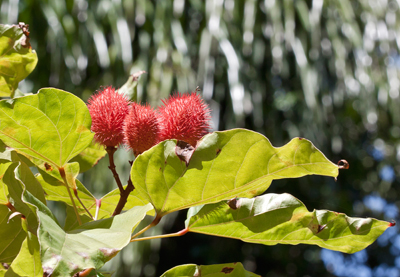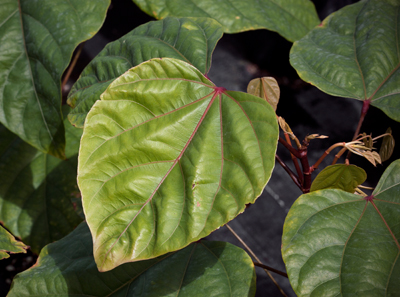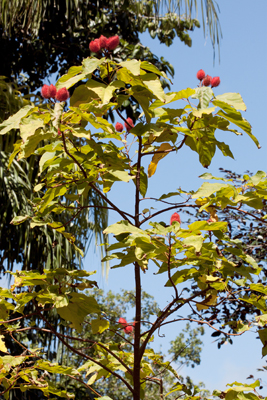Growing annatto

BY KENNETH SETZER
As published in the Miami Herald, 3/28/15.
Answer this plant riddle.
What small tree:
A) is not found in a home improvement store or even in many nurseries;
B) is pretty rare in landscaping, but common commercially;
C) can probably be found in your own kitchen.
To help solve this puzzle, read the ingredients on most any package of American cheese. The answer: Annatto! And it makes a beautiful garden or landscape addition.
For years I had read the ingredients of many foods and wondered what this mysterious ingredient known as annatto could be. It is found in cheese, margarine and many things that need to be tinted yellow, orange or red. Now I am not exactly sure why cheese needs to be dyed to look more like cheese, but I can tell you annatto is a subtropical tree. More specifically, the coloring is derived from the red aril surrounding the actual seeds.
Bixa orellana, aka annatto, is a smallish tree, or shrub, native to tropical areas of Mexico, Central and South America. It’s also found, possibly naturalized, in the Caribbean, and has been introduced as a cash crop in many other tropical parts of the world. It makes an ideal ornamental addition to any landscape found in USDA zones 10–12. That’s us, South Florida, but also Hawaii, Puerto Rico and parts of Southern California.
Though not a native, have no fear as it will not overrun your garden—the example at Fairchild is very well behaved. Bixa will grow to a very workable 20 to 30 feet tall, forming a nice shady but open canopy, while not growing so wide as to out compete nearby plants. Some of its attractive features include its foliage, with fairly large leaves shaped like rotund Valentine hearts. Flowers are pale pink with profuse pink stamens, an appealing source of food for bees.
But undoubtedly its greatest selling point is its striking fruit. After its flowers fade, they give way to seed pods about the size of a smallish lime. Tapering to a slight point (known as acuminate), the pods start out an optimistic bright green and covered with soft spikes. They mature to a deep fiery red. Set against the green foliage and blue sky, these crimson pendants are a striking standout. Unlike the color of most flowers, the red pods remain vivid for quite a while, and mature to a mahogany brown. They then fall to the ground and open to release the pyramidal red seeds within. These are pulverized and used to color foodstuffs, as well as in soaps, cosmetics, candy, popcorn and the wax rind covering on some kinds of cheese. Annatto coloring can also be used as ersatz saffron to yield a similar color without the high price.
Bixa orellana is named for explorer Francisco de Orellana, the first person known to have navigated the entire length of the Amazon River, known at one time as the Rio de Orellana. The native people of the tropics traditionally used the Bixa leaves, seeds and an oil derivative medicinally for myriad ailments, and it is still used today in Central and South America. It indeed seems promising, based on many modern studies, as a source of medicines treating problems ranging from irritated skin to renal functions. With high carotenoid content, annatto may serve as an antioxidant as well. In the wonderful book “Tropical & Subtropical Trees,” Margaret Barwick says annatto once yielded the fabric dye Congo red, long since replaced by synthetics.
Prune your annatto to keep it small and shrubby, or let it grow into a small tree. It prefers full sun, with bright shade acceptable. Adding some compost and mulch to our poor South Florida soil—and keeping it away from salt water or spray—will help keep your annatto happy. Fairchild’s upcoming Spring Garden Festival & Plant Sale on April 11 and 12 will offer annatto plants for sale.

Annatto’s brilliant red seed pods

Tropical, heart-shaped leaves on a young annatto

Annatto stays compact and open.

The mature, brown annatto pod opens to release its seeds.
